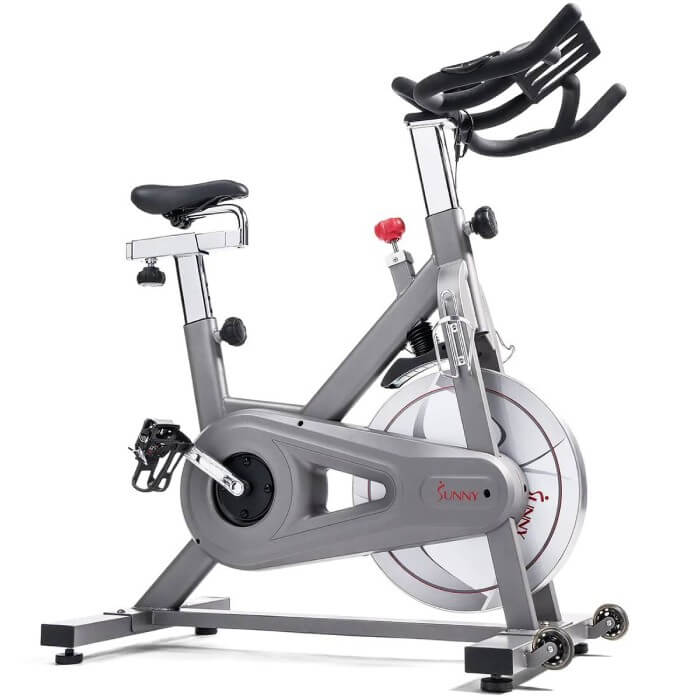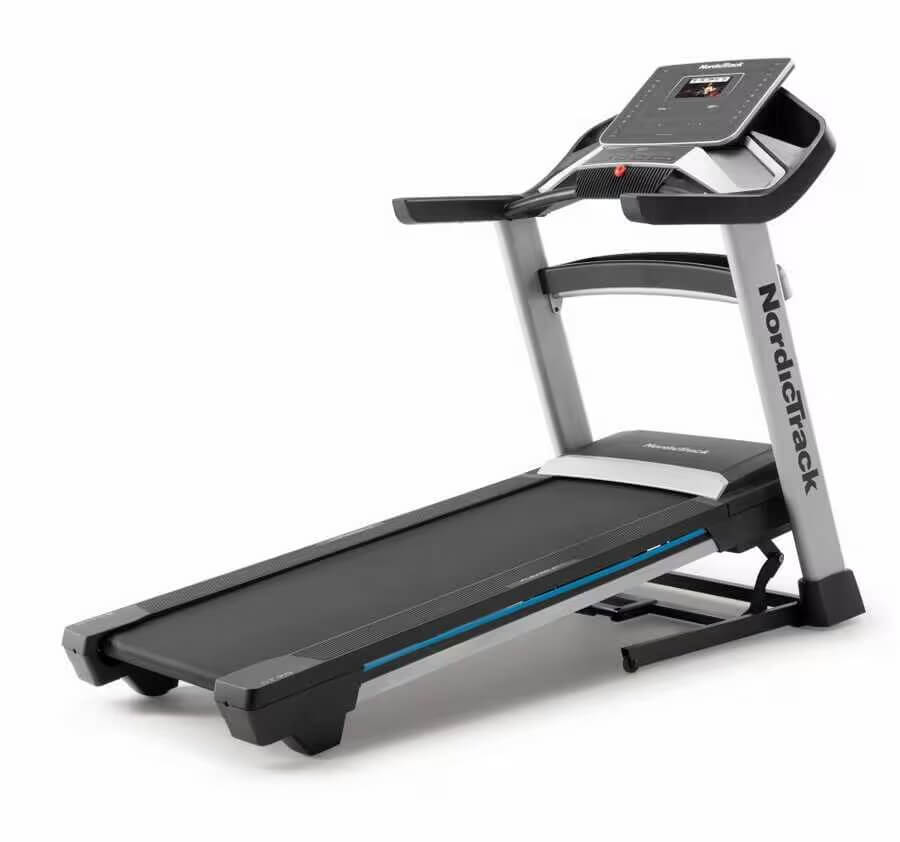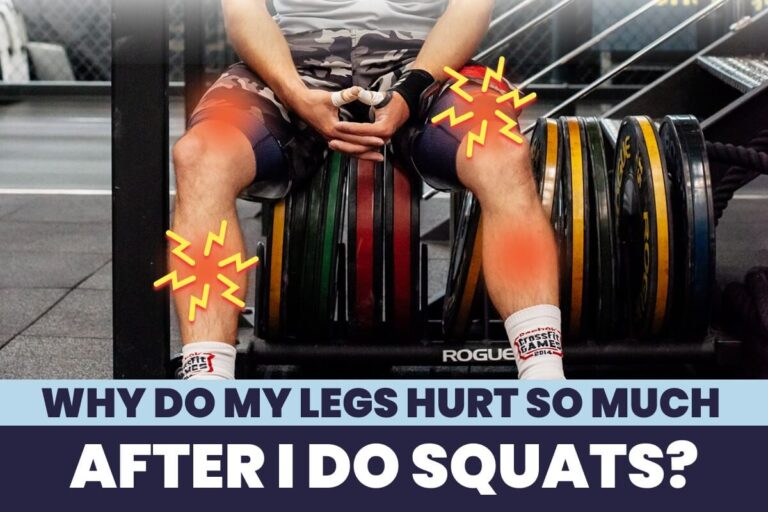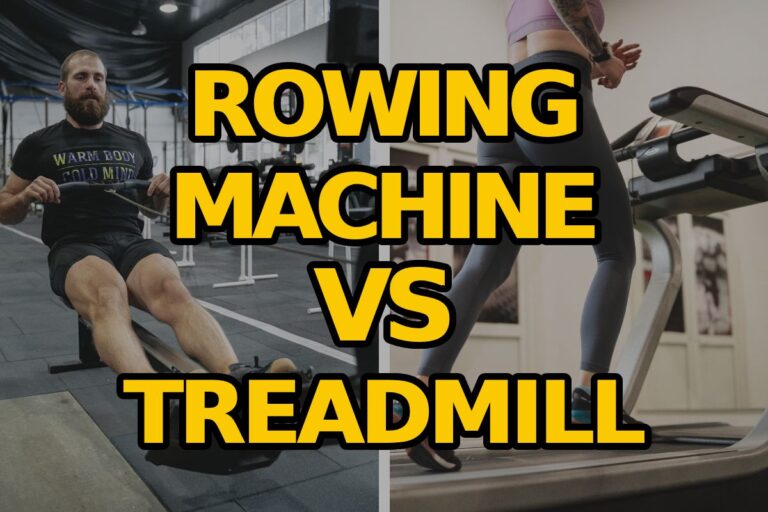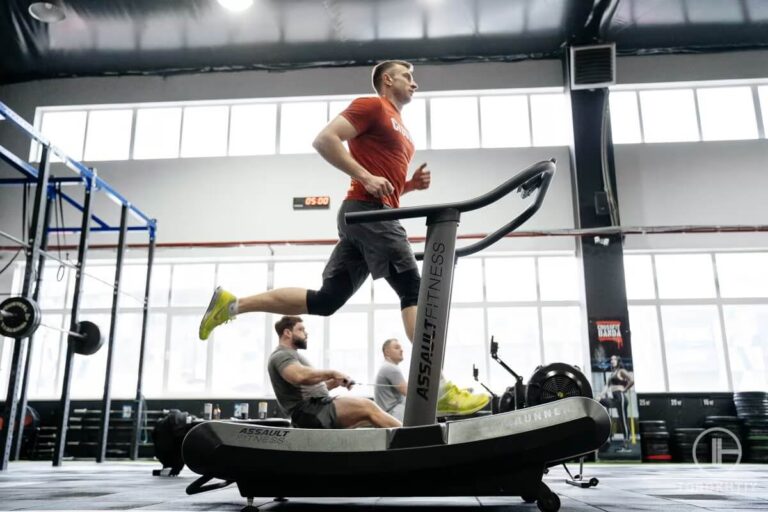Exercise Bike vs Treadmill: The Ultimate Showdown
To run or to bike – that is the question!
Had Shakespeare built a home gym, he would probably wonder the same. In an ideal world, we’ll have all the money and space to stock up on the best fitness equipment. But in reality, we have to prioritize and rationalize our decisions.
That’s where the million-dollar question swoops in, which I’ll break down to you in this comparison of titanic cardio machines: exercise bike vs treadmill.
Exercise Bike vs Treadmill? The difference between treadmills and exercise bikes lies in a slight favor to the former as far as muscle engagement and energy expenditure are concerned, whereas bikes present a low-impact and joint-friendly alternative. The optimum choice comes down to your fitness level and goals.
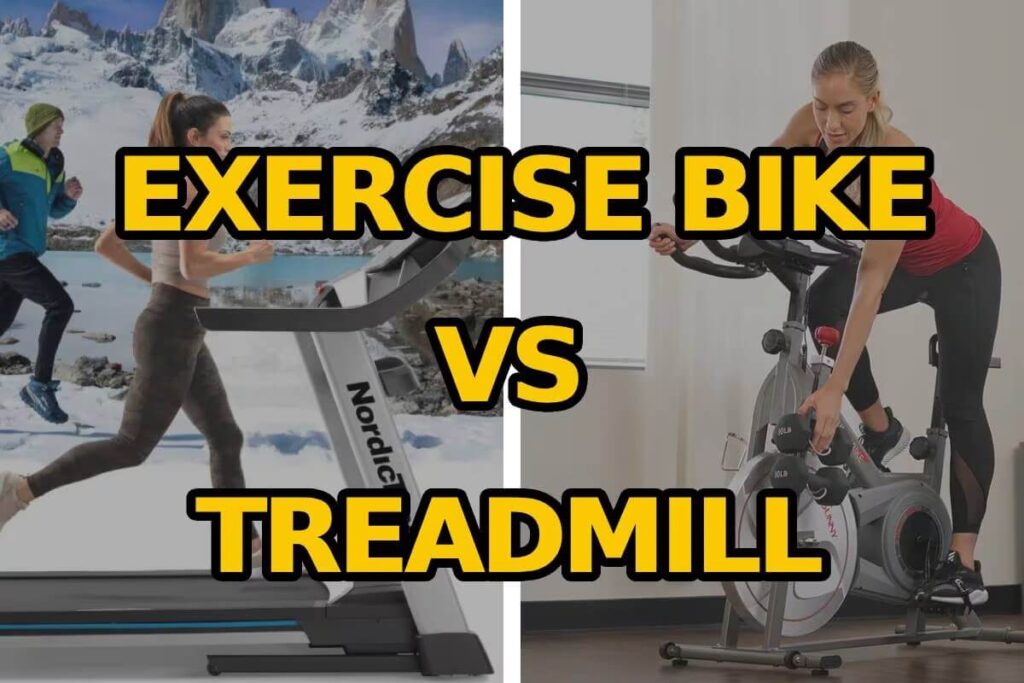
What Is an Exercise Bike?
Exercise bikes are stationary equipment with a saddle, paddles, and handles to give the cycling feel. Several types and variations have surfaced over the years; upright, spin, recumbent, and dual-action, to name a few.
Most are called after the sitting position they encourage, i.e., upright and reclining. A study recorded the same level of trunk and hip activity between the two. However, recumbent bikes are comfy and joint-friendly due to the added back support and outlying pedals. Spin bikes closely mimic road bikes.
They’re the talk of the town and technologically advanced with frictionless flywheels, letting you crank up the resistance with the turn of a knob. Some manufacturers have experimented with dual-action cross-trainers that sport moving handlebars like ellipticals.
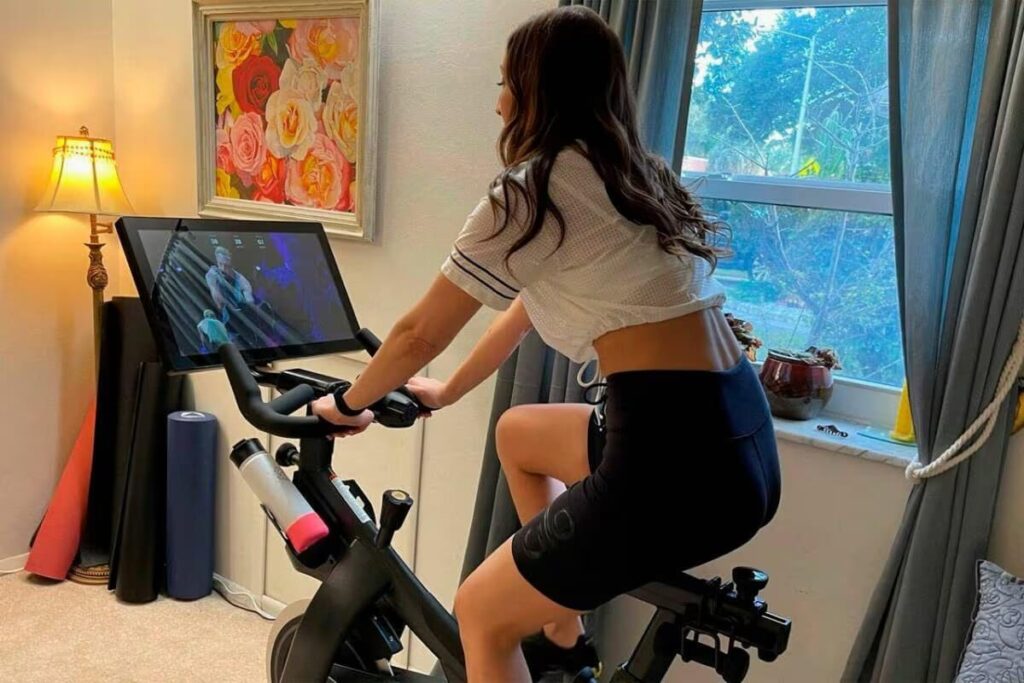
What Is A Treadmill?
A treadmill is one of the most popular over-the-counter cardio machines that allow you to walk, jog, or run indoors. It does so by rotating a belt under your feet at a given pace. Thus, the deck which contains this well-cushioned, rollers-mounted belt becomes the defining feature.
Treadmills are of two types: motorized and non-motorized. With the latter, you have to move the curved tread surface, as no horses are under the hood. It has been shown to elicit a greater cardiometabolic expenditure.
Alternatively, the console of a motorized treadmill puts out all settings: timer, speed, incline, modes, and programs – varying with the make and model. All treadmills have support handles at the elbow height. Non-motorized versions, such as Woodway Curve, fit long grab bars on both ends.
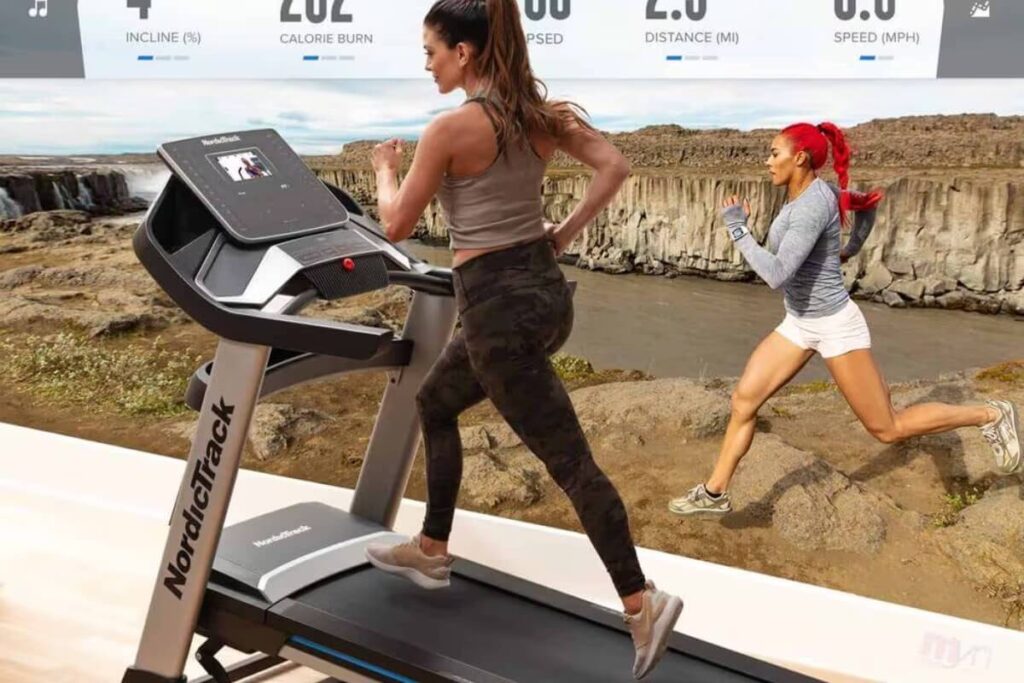
Exercise Bike vs Treadmill: Differences
Which is better, the treadmill or the bike? It boils down to individual preferences and each machine’s exclusive advantages. There’s no one-size-fits-all, etched-in-stone-type answer waiting. However, I’ve pitched both contenders head-to-head to clear the air.
1. Muscles Worked
Exercise bikes engage your lower-body muscles. As you pedal, you primarily work up your glutes, quads, hip flexors, hamstrings, and claves. On the other hand, running on a treadmill recruits your adductors and core to stay upright, besides leg muscles. Putting on an incline increases thigh activity.
You’ll also swing your arms and shoulders to keep up with the treadmill pace. That’s why gym instructors discourage leaning on handles. It gives your upper body a regular light dose – which dual-action bikes (with their moving handlebars) and an enthusiastic session on a spinning bike (since you can stand up on pedals) can match as well.
2. Calorie Burn
Most of the time, we forget the most important muscle in our body: the heart. It’s responsible for pulsating and propelling blood. Cardio revs up your heart rate, strengthening these muscles, supplying nutrient-rich blood, and torching calories.
So, you might be asking, what burns more calories treadmill or bike?
The faster you can kill them off, the closer you get to the dream body shape. A lot of factors have a say. Thankfully, the Harvard Health calorie expenditure chart has summed them all up. Moderate biking is better than walking, but rigorous training on a treadmill is hands down superior.
| Treadmill vs Cycling Average calorie burn per 30 minutes for 125/155/185 lb person | |||
|---|---|---|---|
| Activity | Intensity | Calories | |
| Biking | Moderate | 12-14 mph | 240 to 336 |
| Medium | 14-16 mph | 300 to 420 | |
| Vigorous | 16-19 mph | 360 to 504 | |
| Running | Moderate (walking) | 4 mph | 135 to 189 |
| Medium (8 min/mile) | 7.5 mph | 375 to 525 | |
| Vigorous (6 min/mile) | 10 mph | 453 to 671 | |
3. Workout Intensity
After all, the muscle-building and calorie-blasting potential of a machine depends on the settings dialed in. It’s not straightforward to compare the workout intensity on a treadmill vs stationary bikes. You can do HIIT by alternating short bouts of running at high speeds or cycling at an extreme resistance with rest periods. Similarly, all sorts of bikes and treadmills hand you speed control, making steady-state training possible.
If we juxtapose basic versions of these machines, treadmills will feel more intense at the same level of effort. It’s partly because walking, not cycling, is considered a weight-bearing aerobic activity that might improve bone density.
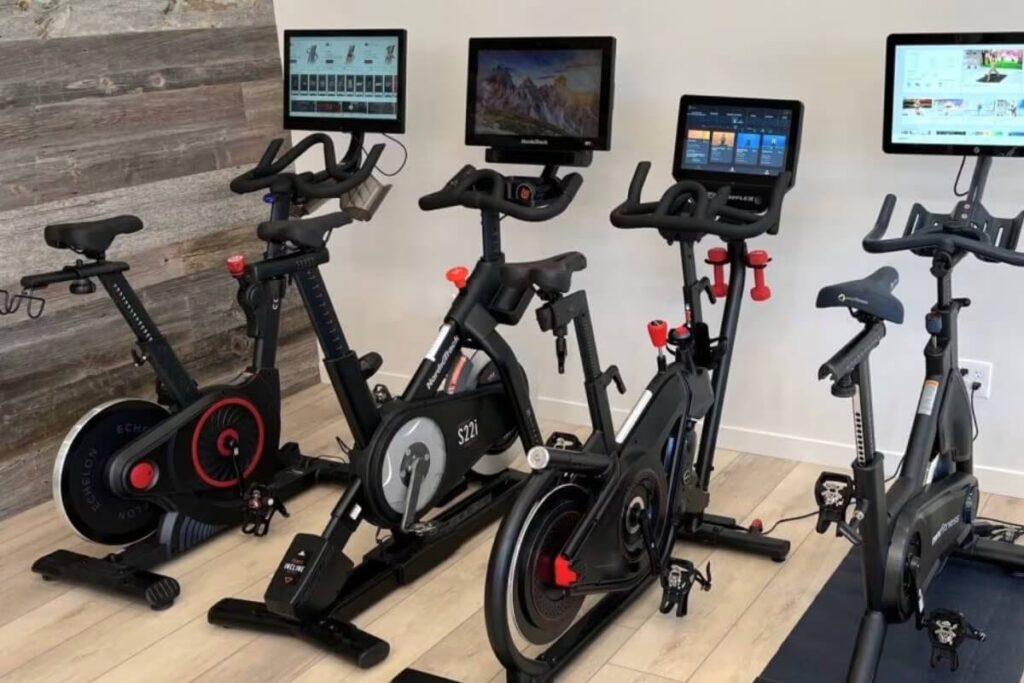
4. Versatility
In almost all instances, treadmills edge above in the versatility of the workouts. For example, you can take a leisure walk, marathon sprint, or uphill trek. The power to change the deck’s incline gradient is a game-changer.
Exercise bikes finish close with their commendable flexibility and streaming options. But you won’t find as many preset programs laid out for you.
5. Adjustability
Bikes are more adjustable. You can set the seat and paddle according to your stature. The four-way adjustments make sure that your knees are locked at an optimal angle and you’re neither slouching nor overextending to get the hold of handles.
High-end treadmills have introduced adjustable cushioning to get soft or firm, depending on the user’s liking, but those are exceptional cases.
6. Injury Prevention
As discussed earlier, running is a weight-bearing exercise which makes it high-impact. If you have damage to your joints, doctors won’t recommend hopping on a treadmill.
Cycling is a much safer alternative. It places less stress on your knees, hips, and connective tissues. This low-impact nature of exercise bike vs treadmill offsets a relatively truncated calorie expenditure.
Treadmills can also throw you off should you ignore the safety leash. Even if you don’t carry existing injuries, riding a bike would expose you to fewer risks. In fact, elite runners compensate for their off-season by adding cycling into the routine and not losing aerobic capacity.
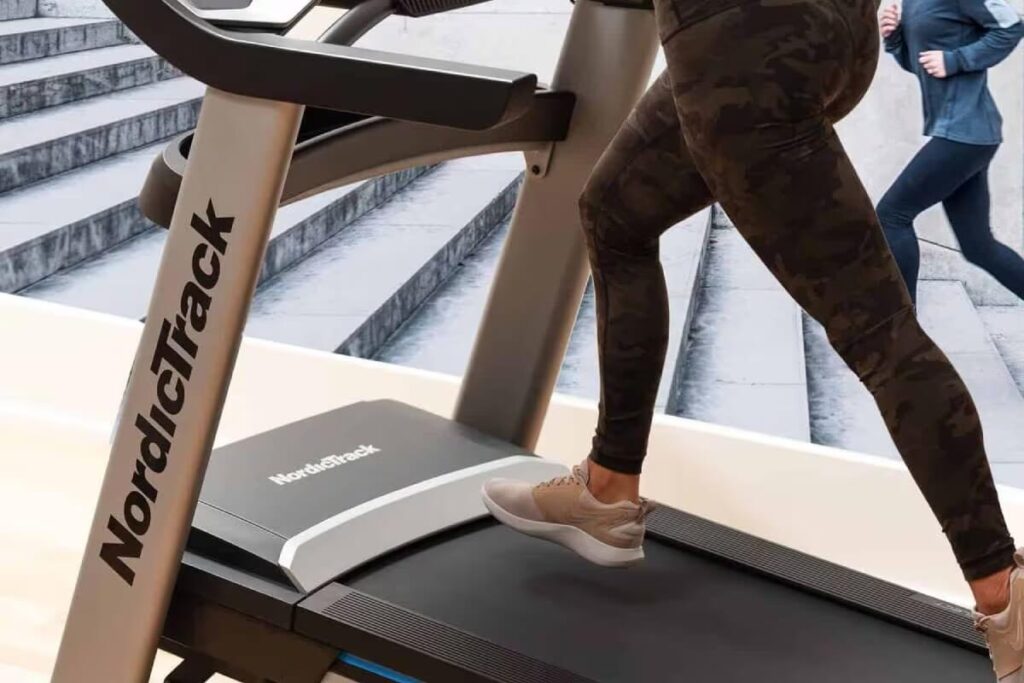
7. Tech Features
Interactive add-ons that make workouts more convenient and enjoyable are the new frontier. And it goes across the fitness industry. You’ll find cardio machines with hi-def integrated tablets, trainer-led studio classes, and real-world virtual tours.
In budget treadmills and bikes, a simple console tracks your performance metrics. You can keep an eye on duration, calories, velocity, and cadence. Bluetooth speakers are now common. If you’re willing to pay a premium, compatible streaming platforms will admit you into the burgeoning community.
Zwift, MyWhoosh, Peloton, JRNY, iFit, Nike Run Club, and SunnyFit are smart choices. However, such models would cost you a higher upfront amount and a recurring monthly setback.
8. Athletic Performance
What fraction of the achieved milestones can you transfer to the outdoor settings? Athletes use treadmills, bikes, or rowers to excel at the original sport. Aside from recumbent ones, stationary bikes have a high transferability.
Studies delving into the differences between treadmill training and overground running present more complexities. Less running economy, changed footstrike biomechanics, and different gait patterns have been separately reported.
Cross-training does breed improved endurance, as the University of Texas has found VO2 max transfer between different modes. Still, sport-specific training is an unbeatable approach. Are you prepping for a 5K run or the Grand Tour?
9. Purchasing Prerequisites
Two constraints determine your buying decisions: budget and space. You can’t select a bike or treadmill for cardio unless it fits the investment outlay and floor area allocated for your personal fitness box.
Treadmills are generally wider, heavier, and costlier than bikes of the same grade. Take Peloton Tread and Bike+, for example, top-of-the-line models in each lineup. There is over a one-third price difference and an 18″ footprint increment between the two.
Furthermore, you need a constant power supply, which limits the spots it can take in a room or garage. However, newer treadmills can be folded up and wheeled out of the way. The Soft Drop hydraulic system also safely lowers the deck to the ground.
A treadmill vs spin bike includes more components. Motors come to the forefront. CHP one controls the speed, and high-trust incline motors lift the deck. Then, there are multiple rollers maintaining the belt tension.
You’ll get a better-quality exercise bike if you’re on a tight budget. Higher cost and vulnerability are inherent to the treadmill structure, not a con of such.
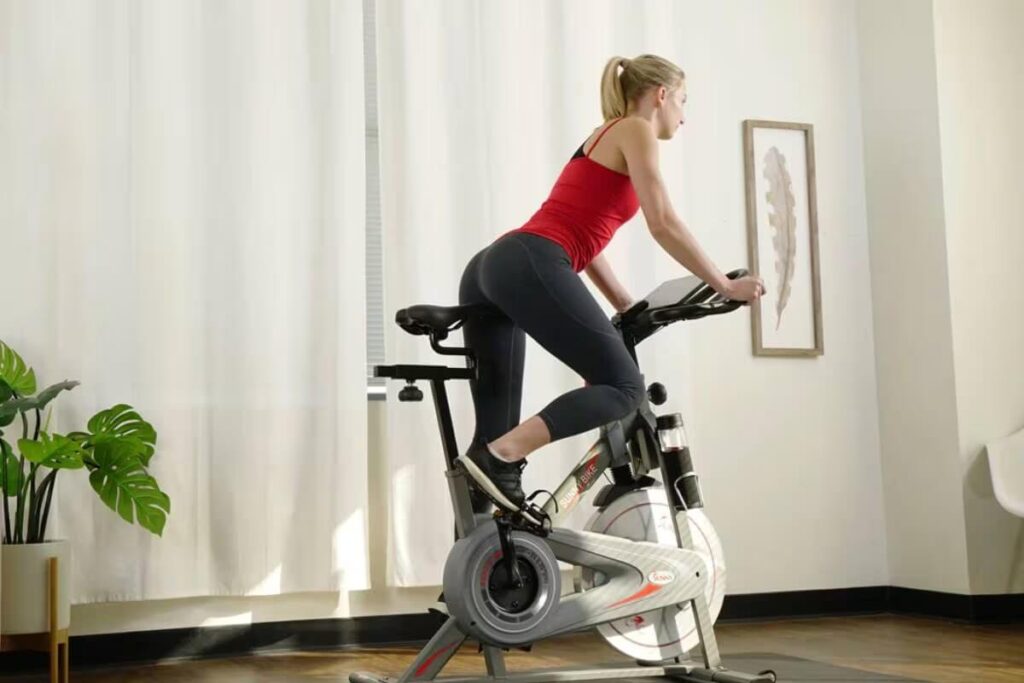
10. Maintenance
The last parameter is maintenance. You must watch your equipment if you don’t want them to break down in the middle of a workout.
Regardless of the coating, the steel frame is susceptible to rust. Therefore, wipe it down with a damp cloth and get rid of the sweat. Then, as specified in the user manual, you’ll have to do a major inspection on a weekly or monthly basis. It’s going to be a lot more time-consuming and nerve-racking on a treadmill vs stationary bike.
Clean and lubricate the areas under the belt, motor, and rollers. Pop off the hood, but ensure you’re not violating the warranty conditions. Since bikes have shifted to contactless magnetic tension, you only need to regularly torque the seat and paddles with wrenches that accompany the package.
Exercise Bike vs Treadmill: Summary
We’ve seen that biking and treading are both proven fitness mantras. Treadmills take a slight lead in muscle activation and energy expenditure, which exercise bikes level off with their low-impact and joint-friendly motion.
Where indoor biking is more transferable to the road, it can’t match one-push features onboard a treadmill. Still confused? Look at the pros and cons of each.
Pros and Cons of a Treadmill:
Positives:
Could be better:
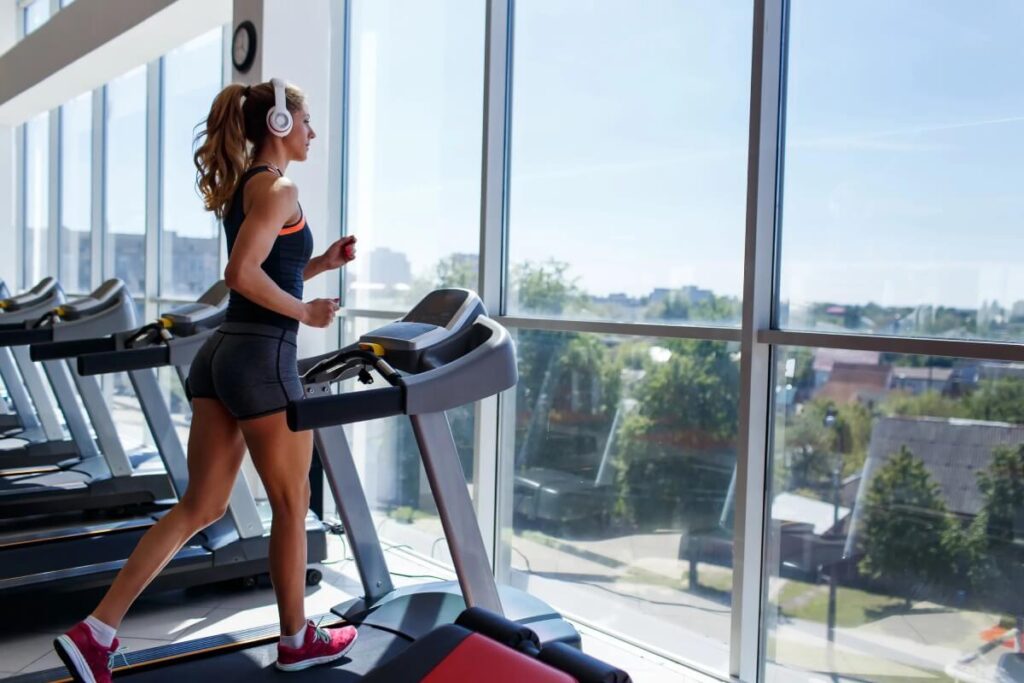
Pros and Cons of an Exercise Bike:
Positives:
Could be better:
Exercise Bike vs Treadmill: When to Use Each?
Having discussed the pros and cons of both machines, let’s see for what purposes and situations you should use them. Make no mistake – you can choose either a treadmill or bike for weight loss, cardiovascular health, general conditioning, and that would be a good decision.
However, the better choice depends upon your fitness level and goals. The treadmill is the way forward if your main focus is to torch max calories in a limited time. Alternatively, bone conditions or balance issues might hold you back.
Your heart pounds fast on stationary bikes, not feet. Considering the negligible performance discrepancy, bikes can be a smarter option, especially for athletes in the beginning phase, physical therapy, or cash-strapped circumstances.
Cross-training crazies will innately incline towards cycling because they also have unstoppable air bikes at the gym.
Ask yourself what excites you. To push pedals with cleats in or to hit the ground running? Opting for the most enjoyable method will help you squeeze out the maximum advantages.
In case you’re training for a certain sport (marathon or cycling), then the conundrum doesn’t exist at all. Anyways, consult your doctor before taking up a new physical activity.
Our Recommended Exercise Bike
Sunny Health & Fitness Synergy Pro is an excellent indoor bike with a 40lb weighted flywheel and micro-adjustable magnetic resistance. The heavy-duty frame supports up to 300 lbs.
The plush seat moves up/down and fore/aft to get tailored for your comfort. It goes with a 29”-40” inseam length. Handlebars boast multiple grips with a urethane-dipped aero bar and heart rate sensors.
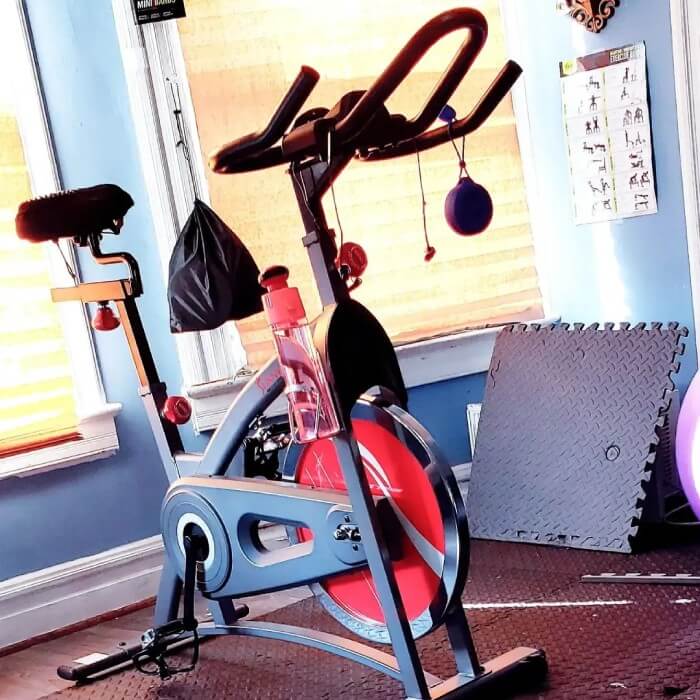
Lastly, the clip-in pedals have a secure toe cage. Anytime you feel like losing control, press the emergency brake to halt the wheel instantly. You’ll find a dumbbell rack and a bottle holder on each side. The console leaves space for a device above so you can watch your favorite shows or follow resourceful lessons on SunnyFit App.
Our Recommended Treadmill – NordicTrack EXP 7i
NordicTrack EXP 7i is reckoned among elite treadmills. It states a 300 lb weight capacity and up to 10-year warranty. The manufacturer has coupled Soft Drop System with one-push Easy Lift Assist for a breezy setup.
It has patented cushioning on a 20″ x 55″ tread belt, grinding on the top of 1.9″ precision balanced rollers with the help of a powerful 2.6 CHP motor. 10 mph top speed and 12% incline are leading characteristics.

You’ll see direct-access buttons lining the console. It hosts a 7″ touchscreen display with built-in premium speakers. NordicTrack gives you a 30-day iFit trial to browse the world’s biggest library, get in touch with professional trainers, and compete in challenges. Afterward, see if you want to continue the subscription.
FAQ
Is A Treadmill Or Exercise Bike Better For Weight Loss?
To lose weight, you have to burn more calories than you intake. You see, it’s a two-pronged approach: diet and exercise. When it comes to the latter part, both treadmills and bikes are awesome calorie-blasting machines.
The exact numbers depend upon your body weight, workout intensity, and duration. Generally, sprinting on a treadmill fares better than bike riding.
In case you’re looking toward a treadmill or exercise bike for belly fat reduction. Remember, it’s not possible to spot-reduce fat from a particular area; rather, it’s a comprehensive process.
Is a Bike or Treadmill Better for Legs?
Both machines work your legs, including glutes, quads, hammies, and calves. However, treadmills are a little better at muscle engagement and afterburn effect due to the fact that you can add an incline or dial up the speed.
Is It Ok to Bike Instead of a Leg Workout?
You can’t swap the entire lower-body training plan with biking only although it would make for a better part of it.
Cycling can be a starting point to build strength and endurance in your legs without stressing joints. Once you’ve taken up more demanding sports like weightlifting or basketball, include compound exercises like squats and lunges.
Conclusion
The exercise bike vs treadmill dichotomy is as old as these cardio machines. One seems to take the lead in activating muscles, burning calories, and providing intense workouts. Simultaneously, the other camp boasts about low-impact nature and outdoor transferability. These differences are so minute that the actual decision rests on your preferences, as treadmills and bikes have distinct motions.
What do you like? To run or to bike? Do share your reasoning in the comment section.
Also read:
- Best Treadmill Under $300
- Best Curved Treadmill
- Best Treadmill Under 2000
- Best Treadmill Under 1000
- Best Treadmills for Running
- Best Commercial Treadmill
- Beginner Treadmill Workout
- Treadmill Maintenance
- Best Small Treadmill for Home
References:
- COMPARISON OF TRUNK AND LOWER EXTREMITY MUSCLE ACTIVITY AMONG FOUR STATIONARY EQUIPMENT DEVICES: UPRIGHT BIKE, RECUMBENT BIKE, TREADMILL, AND ELLIPTIGO® // NCBI: https://www.ncbi.nlm.nih.gov/pmc/articles/PMC4827362/
- Non-motorized Treadmill Running Is Associated with Higher Cardiometabolic Demands Compared with Overground and Motorized Treadmill Running // NCBI: https://www.ncbi.nlm.nih.gov/pmc/articles/PMC5694659/
- Calories burned in 30 minutes for people of three different weights // Рealth: https://www.health.harvard.edu/diet-and-weight-loss/calories-burned-in-30-minutes-for-people-of-three-different-weights
- Exercising with osteoporosis: Stay active the safe way // Рealth: https://www.mayoclinic.org/diseases-conditions/osteoporosis/in-depth/osteoporosis/art-20044989
- Effectiveness of cycle cross-training between competitive seasons in female distance runners // Pubmed: https://pubmed.ncbi.nlm.nih.gov/12741870/
- Better economy in field running than on the treadmill: evidence from high-level distance runners // NCBI: https://www.ncbi.nlm.nih.gov/pmc/articles/PMC4447762/
- Is Motorized Treadmill Running Biomechanically Comparable to Overground Running? A Systematic Review and Meta-Analysis of Cross-Over Studies // NCBI: https://www.ncbi.nlm.nih.gov/pmc/articles/PMC7069922/
- Effect of Treadmill versus Overground Running on the Structure of Variability of Stride Timing// Researchgate: http://surl.li/ijavn
- Effects of cross-training. Transfer of training effects on VO2max between cycling, running and swimming// Pubmed: https://pubmed.ncbi.nlm.nih.gov/7871294/
- Caloric expenditure of aerobic, resistance, or combined high-intensity interval training using a hydraulic resistance system in healthy men// Pubmed: https://pubmed.ncbi.nlm.nih.gov/25162652/
- 5 Workouts That Give You the Afterburn Effect// Healthline: https://www.healthline.com/health/fitness-exercise/afterburn-effect-workouts#
Why Trust Us?
With over 20 years in Olympic Weightlifting, our team does its best to provide the audience with ultimate support and meet the needs and requirements of advanced athletes and professional lifters, as well as people who strive to open new opportunities and develop their physical capabilities with us.
By trusting the recommendations of our certified experts in coaching, nutrition, dietology, and sports training programming, as well as scientific consultants, and physiotherapists, we provide you with thorough, well-considered, and scientifically proven content. All the information given in the articles concerning workout programming, separate exercises, and athletic performance, in general, is based on verified data. We ensure that you can rely on our professionals’ pieces of advice and recommendations that can be treated as personalized ones which will benefit you and fully meet your needs.
The product testing process is described in more detail here
Author: Ihor Shymechko
Pro Olympic Weightlifter, Coach
Best Results: Snatch – 208 kg,
C&J – 240 kg
Ihor has been a professional weightlifter since 1996, boasting over two decades of competition experience. His notable achievements include clinching the European Championship in 2009 and securing a silver medal in the 105kg division at the Senior World Championships in 2011. Ihor represented his country in the 2008, 2012, and 2016 Summer Olympics. After retiring from competitive weightlifting, he transitioned to coaching, leveraging his vast experience to guide athletes who now compete on both national and international stages.

